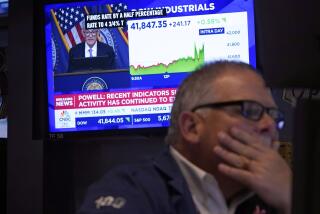Three things to watch for from the Fed and Bernanke on Wednesday
WASHINGTON -- A difficult task awaits Federal Reserve Chairman Ben S. Bernanke when he faces the TV cameras Wednesday in his quarterly news conference.
He has to try to reassure investors, analysts and politicians that the central bank has a plan for scaling back its unprecedented efforts to boost the economic recovery.
At the same time, Bernanke will have to be vague about exactly what that plan involves to avoid boxing in himself and his Fed colleagues as they try to exit from their controversial stimulus policies without damaging the recovery.
QUIZ: How much do you know about sequestration?
And he has to do all that while fending off new questions about his own future as the end of his second term approaches in January.
With the Fed playing an outsized role in the U.S. and global economies, financial markets can gyrate based on Bernanke’s comments.
And there have been a lot of gyrations recently as he and other Fed officials have started addressing the delicate topic of when and how to wrap up stimulus efforts that began nearly five years ago.
“I think markets maybe have gotten a bit ahead of themselves,” said Gus Faucher, senior macro economist at PNC Financial Services Group. “Bernanke will be looking to provide some more details and clarity.”
Here are three things to watch for as Fed policymakers wrap up a two-day meeting and Bernanke answers media questions.
1: Signals in economic projections.
The Federal Open Market Committee isn’t expected to announce any major changes when it issues its policy statement at 2 p.m. Eastern time.
Analysts predict that the Fed will keep the short-term interest rate at near zero and will continue purchasing $85 billion a month in bonds to try to keep long-term interest rates low.
Committee members also are likely to keep their economic projections around the same level as in March, when they predicted moderate growth of no more than 2.8% this year.
But even small changes in those projections could signal when the Fed might act to start reducing its bond purchase.
A slight upgrade of the economic projections would portend action sooner, as early as September. A slight downgrade could mean the Fed would wait longer to act.
2: More clarity on the stimulus exit.It seems everyone in the financial world has an opinion on when the Federal Reserve should start scaling back its stimulus efforts.
Former Fed Chairman Alan Greenspan recently said it should start now. International Monetary Fund Managing Director Christine Lagarde said last week that the tapering should not begin until next year.
Bernanke gave mixed messages when he testified before Congress last month, which helped roil the financial markets.
First he warned against acting too soon because it could damage the recovery. Then he said that if the economy continued to improve, the central bank could start scaling back its stimulus in the next few months.
Diane Swonk, chief economist at Mesirow Financial, expects Bernanke to clarify Wednesday that reducing the monthly purchases is not an end to the stimulus, just a reduction in its size.
“Tapering is not an exit,” she said. The Fed could slowly ratchet down its $85-billion purchases, watching the impact on the economy to make sure it wasn’t acting too quickly.
“The problem is the Fed’s trying to express shades of gray and the market operates in black and white,” she said.
A clear message from Bernanke that the Fed would only be scaling back -- not completely pulling back -- would assure investors that the Fed would continue to support the economy as it starts pulling back on the stimulus, Swonk said.
3. Continued unclarity on Bernanke’s future.
Bernanke is asked at each news conference if he is intends to seek another term as Fed chairman after his second term ends in January. He’s been steadfastly noncommittal.
But Bernanke probably will be pushed more aggressively on the issue Wednesday after President Obama weighed in.
In an interview Monday , Obama suggested that he might not renominate him. Obama noted that Bernanke had already stayed in the job longer than planned.
The comments have prompted a new round of speculation about who will be heading the Fed next year and overseeing a possible stimulus exit.
Bernanke is unlikely to say anything concrete about his future at his news conference. He told Congress last month he was not prepared to answer that question.
He probably simply will reiterate earlier comments that he’s not the only one who could guide the Fed through its stimulus exit.
If Obama does not renominate Bernanke, Fed Vice Chair Janet L. Yellen is the most likely successor. And she has been closely allied with Bernanke.
Faucher said Fed policy was unlikely to change under Yellen.
Bernanke will have to try to convey that message as well Wednesday, Swonk said, adding to the difficulty of his task.
“It just made his job a little harder,” she said.
ALSO: Blue Shield may take L.A. contract from Anthem Blue Cross
High court rules ‘pay-for-delay’ drug deals can face antitrust suits
Tech execs urge U.S. to help clear their names in NSA surveillance
More to Read
Inside the business of entertainment
The Wide Shot brings you news, analysis and insights on everything from streaming wars to production — and what it all means for the future.
You may occasionally receive promotional content from the Los Angeles Times.










